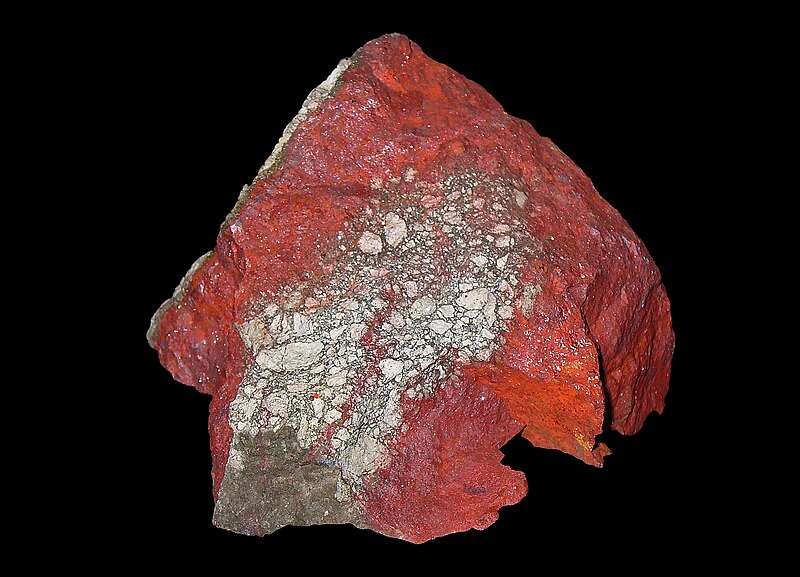
Appearance
Though it occasionally appears in crystals with a nonmetallic adamantine luster, cinnabar is bright scarlet to brick-red in color and is typically found in large, granular, or earthy forms. Its symmetry is similar to that of quartz. It has the second-highest refractive index of any mineral and displays refraction.
Geographical Distribution
Historical Sources: There is a lengthy history of cinnabar mining; noteworthy historical sources include:
China: Cinnabar was widely used in traditional Chinese art and cultural traditions, and ancient China was a major supplier of the material. China has long been recognized for its cinnabar resources, which have been mined for centuries.
Mesoamerica: Cinnabar was also mined by pre-Columbian Mesoamerican societies including the Aztecs and Maya for use as a pigment. Vibrant crimson paintings and artifacts were made with cinnabar.
Spain: Throughout the period of colonialism, Spain was a significant player in the worldwide cinnabar trade and another historical supplier of the material.
Modern Mining: Modern mercury mining continues to take place in many places of the world, even though the mining of cinnabar for artistic and coloring purposes has decreased. Notable areas with mercury mining activities and cinnabar resources include:
China: China is still a major producer of mercury from deposits of cinnabar. It is one of the world’s major producers of mercury and has contemporary mining operations.
Kyrgyzstan: The country of Kyrgyzstan is well-known for its mining operations and cinnabar deposits.
Algeria: The country has mined mercury and possesses quantities of cinnabar.
Spain: There are still cinnabar resources in Spain, but owing to health and environmental concerns, the amount of cinnabar mined for mercury has drastically reduced.
History
Since at least the tenth millennium B.C., numerous societies have mined and used cinnabar as a valuable resource. Another name for cinnabar is “vermilion.”
Chemical Composition
The chemical formula for cinnabar, a naturally occurring mercury sulfide mineral, is HgS.

Uses
Throughout history, cinnabar and its byproducts—most notably mercury—have been used for a wide range of purposes. It’s crucial to remember, though, that a lot of these applications have decreased or been replaced as a result of mercury-related health and environmental issues. Cinnabar and its products are used in the following areas and applications:
- Mercury Production: The main reason cinnabar is mined is to extract its mercury. Mercury vapor is released when the cinnabar is heated and breaks down. Mercury vapor has various applications as liquid, which can be obtained by collecting and condensing it.
- Thermometers: One of the most popular parts of glass thermometers has been liquid mercury. However, due to environmental concerns and the availability of alternative temperature measurement techniques, the usage of mercury in thermometers has decreased.
- Fluorescent Lights: The mercury vapor in fluorescent lights is used. Mercury vapor emits ultraviolet light when an electric current is run through it. This light subsequently reacts with phosphor coatings to produce visible light. Mercury levels in more recent energy-efficient light bulbs have been attempted to be lowered.
- Batteries: Electronic devices, cameras, hearing aids, and other applications have all made use of mercury oxide batteries. However, more ecologically friendly substitutes are gradually replacing conventional batteries.
- Electrical Switches and Relays: Because of its dependable performance, mercury-wetted switches and relays were formerly widely used in electrical applications. Because of environmental concerns, solid-state electronics have mostly supplanted them.
- Gold and Silver Mining: Precious metals have been extracted from ore using mercury in small-scale gold and silver mining operations. This technique, called amalgamation, is prohibited or outlawed in many places because of the significant health and environmental concerns it brings.
- Art and Pigments: Cinnabar has long been used as a red pigment in art, producing vermilion, a striking shade of red. But because mercury is so hazardous, its use has drastically decreased, and safer colors are now used in art and restoration.
- Traditional Medicine: Cinnabar was employed in several ancient remedies, but because of worries about mercury toxicity, its use has mostly ceased.
- Cultural and Spiritual Practices: Cinnabar has been a part of many spiritual and cultural traditions, especially in Chinese culture, where it was employed in funeral rites and believed to grant immortality.
Table





